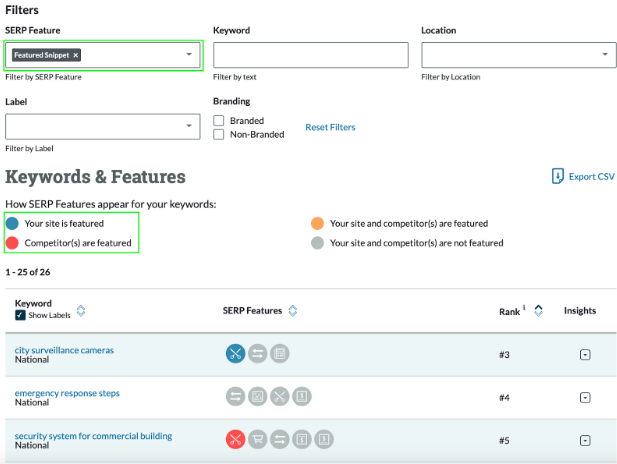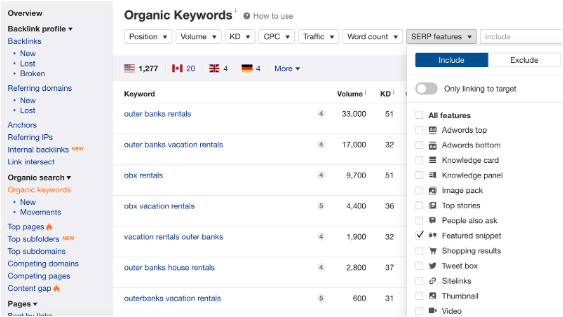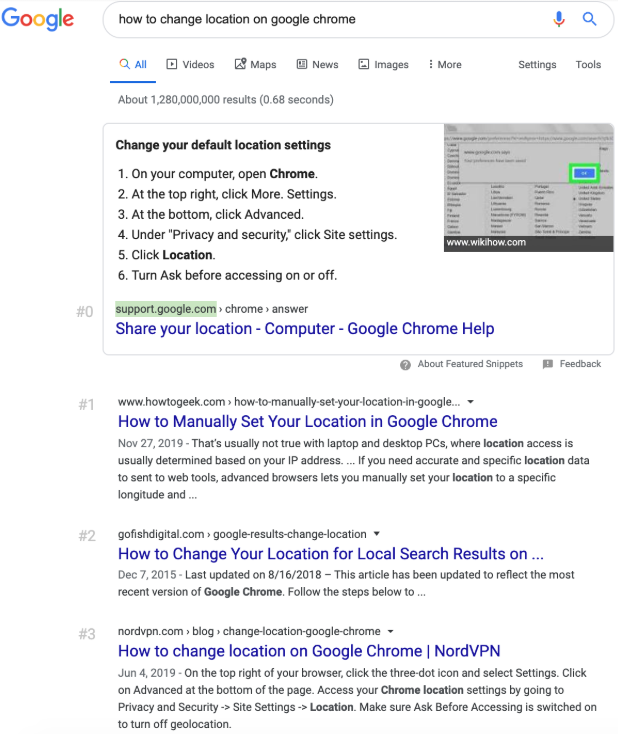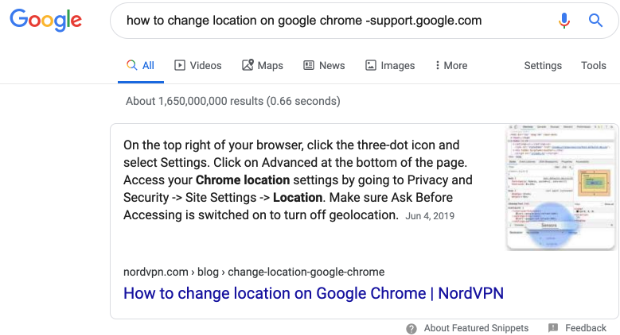Table of Contents
What is a Featured Snippet?
A featured snippet, also known as an “answer box”, is a special box that aims to answer a user’s query in the search results by algorithmically finding and extracting the answer from a webpage’s content. Answer box featured snippets appear at the top of Google’s search results for certain keywords. It is especially common for question searches, such as phrases that start with “who,” “what,” “where,” or “why.”

The idea behind featured snippets is to give users an answer to their query without them even having to click into a webpage. This is great for users because they can find answers to their questions quickly and easily since Google has already done the hard work of pulling the answer out of a page’s content and neatly displaying that answer within the search results page.
Getting your content featured in an answer box snippet can increase your visibility because featured snippets tend to be placed near the top of Google’s search results where they naturally draw users’ attention. This can help increase traffic to the site, if the answer isn’t entirely shown in the SERP.
Related Content:
Keep in mind, that there is a fine balance between providing a strong answer to a query, and providing so much information that users no longer need to click through to your site. This is especially true now because as of January 23, 2020 Google changed the way featured snippets appear in the search results. Now, if your site is in the featured snippet, it will no longer appear in the regular organic results at the same time. I still believe that answer box snippets can be valuable, we just need to keep CTR optimizations in mind as well.
How do you optimize for featured snippets?
First, you need to identify your “low-hanging fruit” opportunities. Featured snippets can be very competitive to get into because they are prominently placed in the search results, which can attract a lot of traffic to the site (in cases where the query isn’t entirely answered). For that reason, it is also important to research the competition and try to understand what Google is looking for in an ideal answer. Then you should optimize your content and consider additional tactics like structured data markup. For more details, read these 5 steps to earn a featured snippet:
1) Identify strong opportunities
The first step towards earning a featured snippet is to uncover the most promising opportunities for your content. To do this, start by pinpointing relevant keywords that already have a featured snippet in Google’s search results. If you are running a Moz Pro campaign, you can use the “SERP Features” tool by going to Campaigns > Rankings > SERP Features. This will show you the keywords where either you or one of your competitors currently appears in a featured snippet. If you use this tool, I recommend using the “SERP Feature” filter to only display keywords with a featured snippet in its SERP. Then, sort the rankings in ascending order to see where your site is ranking near the very top of Google (around positions 1-5 organically). The ideal targets will be the terms where you are already ranking well but a competitor’s page is currently featured in the answer box snippet.

If you don’t have Moz Pro, you can also utilize Ahrefs to identify opportunities. Simply use Ahrefs’s “SERP Features” filter within the Keywords Explorer tool or the Site Explorer tool in the Organic Search > Organic Keywords section to show only keywords that have a featured snippet in the search results.


Besides Moz and Ahrefs, you can also use the keyword tracking tool STAT to filter for keywords with strong featured snippet opportunities. You will want to filter down to just the terms that have an answer box featured snippet in the SERP, and then sort those by your ranking position. Again, the strongest opportunities will be the keywords where your site is ranking near the very top of Google, but the featured snippet is currently occupied by a competitor.
Another way to see if a particular keyword would be a good target for featured snippet optimizations is to use search operators to see how close your page is to actually getting featured. By using this search operator: [keyword] -[CompetitorSite.com], you can see what Google’s search results would look like if the competitor that is currently in the featured snippet didn’t exist.
For example, in a regular search for the keyword “how to change location on google chrome”, support.google.com is currently in the featured snippet.

If we remove support.google.com from the search results using the search operator “-support.google.com”, we can see that nordvpn.com, which was originally ranking 3rd, is next in line to earn the featured snippet.

If it’s your page that shows up in the answer box once the competitor page is removed, you know that Google considers your page the “runner-up” for that featured snippet. If a different competitor appears in the snippet, you can use the same search operator to view the SERP minus that domain as well. Just keep subtracting the featured page until you see your site appear in the answer box. If only one or two competitors are in line before you, that is an indication that your page is very close to getting featured and some content updates may be enough to take over the snippet.
2) Analyze the current featured snippet and associated competitor page
Once you have a keyword target picked out, take some time to analyze the current featured snippet. This can give you insights into what Google is looking for for that particular snippet. First take note of the snippet’s format. Is the featured snippet a paragraph, table, numbered-list or bulleted-list? Providing your answer in the same format may help get it featured since Google has already shown that it likes that answer format for this particular query.
It can also be helpful to analyze the wording of the current snippet. Take note of its strong and weak points. Does it provide the best possible answer to the query? If not, how could it be improved? Update your content to provide an even stronger answer to the query. Keep in mind though, featured snippets are meant to be short (usually around 3-4 sentences). To be on the safe side, your answer should be about the same length as the current featured snippet.
It’s also a good idea to review the competitor page that’s currently being featured. See how their content is formatted. Is the copy that’s being pulled into the snippet right at the top of the page, or is it buried in the middle? (Most of the time it will be near the top of the page and directly below an H1 or H2 header.) You should also ask – “Is their page a blog post or a service page?” This can help give you insights into how best to format your own page, or if your page is even a good contender for that particular snippet. If the currently featured page is a detailed blog post, but your top-ranking page for the query is a service page with very little copy, it may be worth exploring other snippet opportunities instead.
3) Make sure your copy is well organized and clearly structured
It is important to make sure that your copy is clearly structured and well organized. Properly structured header tags is one way to make sure your content is clearly organized. If you’re an SEO you probably already know this, but here is a refresher on how to structure your header tags: each page should have one H1 header which describes the topic of the overall page. H2 headers represent sub-topics. H3s are sub-categories within the H2s, and so on. Your header tags should be organized in the same way that you would organize a research paper. Create a main topic, then sub-topics, then sub-sub-topics within those and go from there.
Proper header tag hierarchy is especially important for targeting list-type featured snippets because it helps Google understand how the content is structured. It is common to see the full question in an H2 header and then the answer in H3 headers listed below that. Google associates the H3 headers as sub-topics related to the H2, which makes it easier to see the Q/A relationship and pull it into a featured snippet.
Be sure to include the full question you are trying to answer in an H1 or H2 header. The answer to that query should be placed within the first sentence or two directly below the header. This is primarily helpful for paragraph featured snippets because the close proximity of the question & answer makes it easy for Google to recognize the Q/A correlation and pull it into an answer box. Remember, we are optimizing this for a robot so we should try to make it as easy as possible for a robot to understand (while also keeping user experience in mind).
Some queries are best answered in a table format, so Google will sometimes pull an entire table into a featured snippet. If your content includes a table, it is a good idea to define the different parts of the table with HTML tags (<tr>, <th> and <td>). For more information on how to use HTML tags for tables, see this resource: https://www.w3schools.com/html/html_tables.asp.
4) Answer the question quickly and simply
Now to the most important part, answering the question. Remember, Google is in the business of answering users’ questions as quickly and easily as possible. So if you can provide the best answer to a query, chances are good that you will appear in a featured snippet.
First, you should select the content on your page that best answers the question or is most similar to the current featured snippet content. Rewrite the copy to answer the question in a similar format and wording as the current featured snippet. If your existing content does not answer the target question at all, a bit of new copy may be needed.
Next, find ways to improve upon the answer. Having content exactly like the current snippet isn’t enough. The following are tactics you can employ in order to strengthen your answer:
Make it simple and succinct.
“Fluff” or unnecessary details can complicate the answer and make it harder for users and search engines to understand.
Get straight to the point.
The very first sentence below the header with your target question should start with “[keyword] is…” and immediately answer the question. Examples:
- Q: What is a qui tam lawsuit?
- A: “A qui tam lawsuit is…”
- Q: How do you file taxes?
- A: “You can file taxes by…”
Cite an expert as the author (if possible).
If you can get an industry expert to write the answer to your question, Google is more likely to use that content in a featured snippet because it comes from a trusted source. It is suspected that Google has integrated E-A-T (expertise, authoritativeness, and trust) more into its ranking considerations.
Your answer may be a direct quote from the expert, or maybe the expert is the author of your entire article (even better!). Either way, make sure to include the expert’s name and ideally a link to an author bio that lists their credentials.
Keep it non-branded and in a general format that doesn’t need additional context.
Remember, featured snippets appear directly in the search results so users are reading that snippet without the context of your website. That is why general, non-branded copy tends to make stronger answer box content.
Add a relevant image.
Most featured snippets include an image in the upper-right corner. The image is sometimes pulled from a different site than the actual copy. Make it easy for Google by including a relevant image near your optimized copy. Google may reward this by featuring your page over another.
5) Consider adding structured data
There is some debate in the SEO community over whether structured data is helpful for earning featured snippets or not. It’s certainly not required, but it may still help give you an edge over competitors. Structured data is code that tells search engines what different items are on your page. So for example, if you write an article on how to do something you can add “How-To” structured data markup to tell Google that your content specifically explains how to do something. Here are some types of structured data to consider when optimizing for featured snippets:
- Article
- ItemList
- How-To
“ItemList” structured data may be helpful if you are targeting a numbered or bulleted list type of snippet, especially if your header tags don’t make it clear where the list starts and ends. General “Article” markup can also be useful because you can include your relevant image and/or cite your trustworthy author in the code. Also keep in mind that Google prefers Schema.org JSON-LD structured data specifically. Once you are finished adding structured data to the page, be sure to test your markup for errors with Google’s Structured Data Testing tool: https://search.google.com/structured-data/testing-tool/u/0/. You can also use this free tool to see if your page is eligible for rich results based on its markup: https://search.google.com/test/rich-results.
Conclusion
Featured snippets are typically in a prime location of SERP real estate, so they can be competitive to earn. Have no fear of the elusive answer box though! Just remember to identify the most ideal keyword opportunities, examine the current snippet and competitor page, clearly organize your content, provide a clear, strong answer and consider additional tactics such as structured data markup. If you follow this advice, you should be well on your way to earning a featured snippet.
Search News Straight To Your Inbox
*Required
Join thousands of marketers to get the best search news in under 5 minutes. Get resources, tips and more with The Splash newsletter: